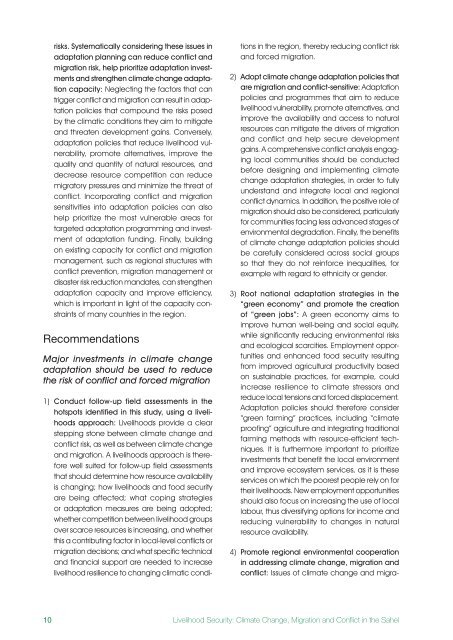Livelihood Security: Climate change, conflict and migration in - UNEP
Livelihood Security: Climate change, conflict and migration in - UNEP
Livelihood Security: Climate change, conflict and migration in - UNEP
You also want an ePaper? Increase the reach of your titles
YUMPU automatically turns print PDFs into web optimized ePapers that Google loves.
10<br />
risks . Systematically consider<strong>in</strong>g these issues <strong>in</strong><br />
adaptation plann<strong>in</strong>g can reduce <strong>conflict</strong> <strong>and</strong><br />
<strong>migration</strong> risk, help prioritize adaptation <strong>in</strong>vestments<br />
<strong>and</strong> strengthen climate <strong>change</strong> adaptation<br />
capacity: Neglect<strong>in</strong>g the factors that can<br />
trigger <strong>conflict</strong> <strong>and</strong> <strong>migration</strong> can result <strong>in</strong> adaptation<br />
policies that compound the risks posed<br />
by the climatic conditions they aim to mitigate<br />
<strong>and</strong> threaten development ga<strong>in</strong>s. Conversely,<br />
adaptation policies that reduce livelihood vulnerability,<br />
promote alternatives, improve the<br />
quality <strong>and</strong> quantity of natural resources, <strong>and</strong><br />
decrease resource competition can reduce<br />
migratory pressures <strong>and</strong> m<strong>in</strong>imize the threat of<br />
<strong>conflict</strong>. Incorporat<strong>in</strong>g <strong>conflict</strong> <strong>and</strong> <strong>migration</strong><br />
sensitivities <strong>in</strong>to adaptation policies can also<br />
help prioritize the most vulnerable areas for<br />
targeted adaptation programm<strong>in</strong>g <strong>and</strong> <strong>in</strong>vestment<br />
of adaptation fund<strong>in</strong>g. F<strong>in</strong>ally, build<strong>in</strong>g<br />
on exist<strong>in</strong>g capacity for <strong>conflict</strong> <strong>and</strong> <strong>migration</strong><br />
management, such as regional structures with<br />
<strong>conflict</strong> prevention, <strong>migration</strong> management or<br />
disaster risk reduction m<strong>and</strong>ates, can strengthen<br />
adaptation capacity <strong>and</strong> improve efficiency,<br />
which is important <strong>in</strong> light of the capacity constra<strong>in</strong>ts<br />
of many countries <strong>in</strong> the region.<br />
Recommendations<br />
Major <strong>in</strong>vestments <strong>in</strong> climate <strong>change</strong><br />
adaptation should be used to reduce<br />
the risk of <strong>conflict</strong> <strong>and</strong> forced <strong>migration</strong><br />
1) Conduct follow-up field assessments <strong>in</strong> the<br />
hotspots identified <strong>in</strong> this study, us<strong>in</strong>g a livelihoods<br />
approach: <strong>Livelihood</strong>s provide a clear<br />
stepp<strong>in</strong>g stone between climate <strong>change</strong> <strong>and</strong><br />
<strong>conflict</strong> risk, as well as between climate <strong>change</strong><br />
<strong>and</strong> <strong>migration</strong>. A livelihoods approach is therefore<br />
well suited for follow-up field assessments<br />
that should determ<strong>in</strong>e how resource availability<br />
is chang<strong>in</strong>g; how livelihoods <strong>and</strong> food security<br />
are be<strong>in</strong>g affected; what cop<strong>in</strong>g strategies<br />
or adaptation measures are be<strong>in</strong>g adopted;<br />
whether competition between livelihood groups<br />
over scarce resources is <strong>in</strong>creas<strong>in</strong>g, <strong>and</strong> whether<br />
this a contribut<strong>in</strong>g factor <strong>in</strong> local-level <strong>conflict</strong>s or<br />
<strong>migration</strong> decisions; <strong>and</strong> what specific technical<br />
<strong>and</strong> f<strong>in</strong>ancial support are needed to <strong>in</strong>crease<br />
livelihood resilience to chang<strong>in</strong>g climatic condi-<br />
tions <strong>in</strong> the region, thereby reduc<strong>in</strong>g <strong>conflict</strong> risk<br />
<strong>and</strong> forced <strong>migration</strong>.<br />
2) Adopt climate <strong>change</strong> adaptation policies that<br />
are <strong>migration</strong> <strong>and</strong> <strong>conflict</strong>-sensitive: Adaptation<br />
policies <strong>and</strong> programmes that aim to reduce<br />
livelihood vulnerability, promote alternatives, <strong>and</strong><br />
improve the availability <strong>and</strong> access to natural<br />
resources can mitigate the drivers of <strong>migration</strong><br />
<strong>and</strong> <strong>conflict</strong> <strong>and</strong> help secure development<br />
ga<strong>in</strong>s. A comprehensive <strong>conflict</strong> analysis engag<strong>in</strong>g<br />
local communities should be conducted<br />
before design<strong>in</strong>g <strong>and</strong> implement<strong>in</strong>g climate<br />
<strong>change</strong> adaptation strategies, <strong>in</strong> order to fully<br />
underst<strong>and</strong> <strong>and</strong> <strong>in</strong>tegrate local <strong>and</strong> regional<br />
<strong>conflict</strong> dynamics. In addition, the positive role of<br />
<strong>migration</strong> should also be considered, particularly<br />
for communities fac<strong>in</strong>g less advanced stages of<br />
environmental degradation. F<strong>in</strong>ally, the benefits<br />
of climate <strong>change</strong> adaptation policies should<br />
be carefully considered across social groups<br />
so that they do not re<strong>in</strong>force <strong>in</strong>equalities, for<br />
example with regard to ethnicity or gender.<br />
3) Root national adaptation strategies <strong>in</strong> the<br />
“green economy” <strong>and</strong> promote the creation<br />
of “green jobs”: A green economy aims to<br />
improve human well-be<strong>in</strong>g <strong>and</strong> social equity,<br />
while significantly reduc<strong>in</strong>g environmental risks<br />
<strong>and</strong> ecological scarcities. Employment opportunities<br />
<strong>and</strong> enhanced food security result<strong>in</strong>g<br />
from improved agricultural productivity based<br />
on susta<strong>in</strong>able practices, for example, could<br />
<strong>in</strong>crease resilience to climate stressors <strong>and</strong><br />
reduce local tensions <strong>and</strong> forced displacement.<br />
Adaptation policies should therefore consider<br />
“green farm<strong>in</strong>g” practices, <strong>in</strong>clud<strong>in</strong>g “climate<br />
proof<strong>in</strong>g” agriculture <strong>and</strong> <strong>in</strong>tegrat<strong>in</strong>g traditional<br />
farm<strong>in</strong>g methods with resource-efficient techniques.<br />
It is furthermore important to prioritize<br />
<strong>in</strong>vestments that benefit the local environment<br />
<strong>and</strong> improve ecosystem services, as it is these<br />
services on which the poorest people rely on for<br />
their livelihoods. New employment opportunities<br />
should also focus on <strong>in</strong>creas<strong>in</strong>g the use of local<br />
labour, thus diversify<strong>in</strong>g options for <strong>in</strong>come <strong>and</strong><br />
reduc<strong>in</strong>g vulnerability to <strong>change</strong>s <strong>in</strong> natural<br />
resource availability.<br />
4) Promote regional environmental cooperation<br />
<strong>in</strong> address<strong>in</strong>g climate <strong>change</strong>, <strong>migration</strong> <strong>and</strong><br />
<strong>conflict</strong>: Issues of climate <strong>change</strong> <strong>and</strong> migra-<br />
<strong>Livelihood</strong> <strong>Security</strong>: <strong>Climate</strong> Change, Migration <strong>and</strong> Conflict <strong>in</strong> the Sahel

















